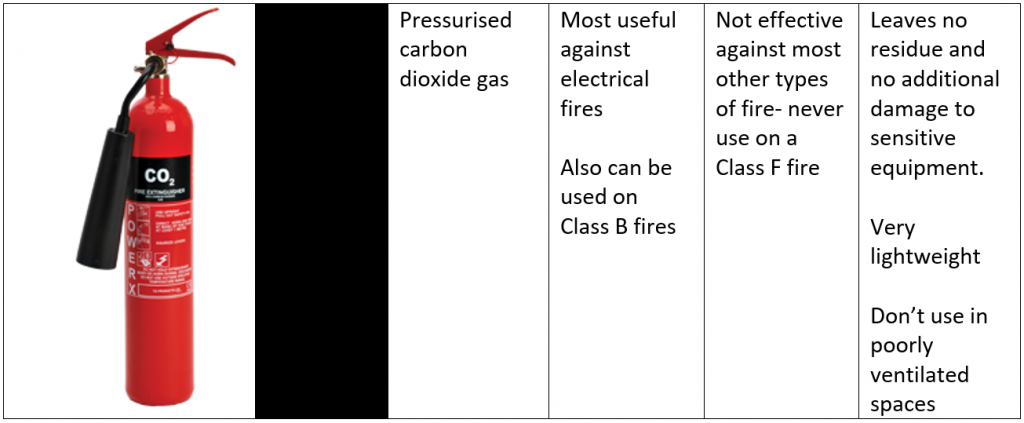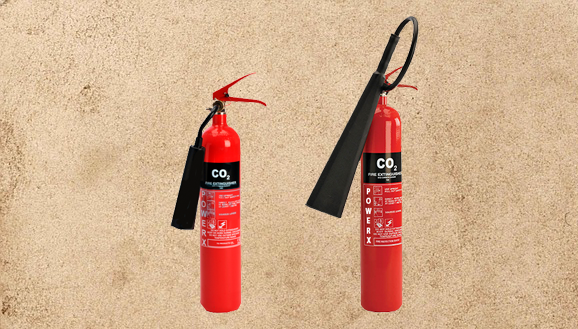Chapter 4 – The Carbon Dioxide Fire Extinguisher.
In this chapter of our detailed guide to fire extinguishers we will be looking at one of the most useful extinguishers of the modern age- the Carbon dioxide extinguisher. Developed by Bell to put out fires inside their telephone switchboards, CO2 extinguishers have become a staple of our fire-fighting arsenal since their invention, due to their unique effectiveness against electrical fires.
The Overview:

The Details:
Carbon dioxide fire extinguishers have revolutionised our ability to tackle electrical fires. Electrical fires no longer have a separate class of their own, since for the most part once an electrical appliance is switched off and unplugged it can be tackled as an ordinary fire would be, but there are some occasions where this is not possible- and that is where the CO2 extinguisher comes in. Recognisable by a black panel on the side of the extinguisher the CO2 extinguisher has the ability to put out electrical fires without leaving a trace of residue behind, minimising damage to your property, and is non-conductive so prevents no risk of shock to the operator. Carbon dioxide fire extinguishers are also rated for use on Class B fires, involving flammable liquids like petrol, oil and paint. They are incredibly lightweight, easily portable, and very durable, but should be used with care.
Is A Carbon Dioxide Fire Extinguisher Right For You?
If you have expensive or important electrical equipment in your home or business, a carbon dioxide extinguisher would usually be a perfect fit. Whether it’s a home office, an expensive sound system, or a gaming PC a carbon dioxide extinguisher is an excellent way to protect your electrical possessions in the home. In the workplace, server rooms, electronic tills, offices with multiple computers– anywhere that there is an important electronic piece of machinery, all these facets of the modern business can be protected by investing in carbon dioxide fire extinguishers. Carbon dioxide fire extinguishers can also be used in the car, and in hospitals, and are even used on film sets to extinguish burning stuntmen in action scenes.
Carbon dioxide extinguishers, as we have said above, are also rated for use on Class B fires. This means they can also be incredibly useful in garages, warehouses, forecourts and artists’ studios. The ability to protect without leaving any residue is such a huge advantage in keeping your precious possessions safe. If you think a carbon dioxide extinguisher would be of use to you, our friendly advisors will be happy to help you find the perfect one. Call us today on 01785 252568.
How Does A Carbon Dioxide Fire Extinguisher Work?
We’ve talked multiple times in this series about the fire tetrahedron. The fire tetrahedron consists of fuel, heat, oxygen and a chemical reaction. A fire can only exist when all four elements of the fire tetrahedron are present. A carbon dioxide fire extinguisher works by displacing the oxygen around the burning fuel, effectively smothering the fire. The carbon dioxide released is also incredibly cold, and carbon dioxide extinguishers should be used with care as incorrect handling of the extinguisher during use could result in cold burns or frostbite. It is also wise to be careful if directing the extinguisher towards another person for this reason.
How Should I Store and Maintain A Carbon Dioxide Fire Extinguisher?
Any fire extinguisher should be commissioned and installed by a BAFE certified engineer. Carbon dioxide fire extinguishers should be sited 10m from a recognised hazard if being used for Class B fires, and close to the electrical equipment they are expected to protect if used for electrical hazards. It is recommended that carbon dioxide fire extinguishers be installed in pairs. You should be performing a visual inspection on your carbon dioxide fire extinguisher at least once a month, to check the pressure gauge if one is available and to check for any dents, leakage, or signs of tampering. A full inspection should be carried out every 12 months from the date of installation by a qualified individual. Unlike other kinds of fire extinguisher, every 10 years the canister should be completely discharged and refilled. This makes the carbon dioxide extinguisher the longest-lasting of the extinguisher types. If your fire extinguisher has been used, regardless of the amount, it should be completely discharged and refilled as soon as possible.
How Do I Use A Carbon Dioxide Fire Extinguisher?
| P | Pull the pin from the side of the handle, being careful not to hold the extinguisher near the horn, as it can become dangerously cold and you can be at risk for cold burns. Make sure you are in a well-ventilated area. |
| A | Aim the hose at the base of the fire to ensure the carbon dioxide reaches the burning fuel |
| S | Squeeze the lever to release the carbon dioxide at a steady pressure. |
| S | For a Class B fire you should sweep the hose from side to side across the burning area, being careful not to allow the force of the gas to spread the burning liquid into other sources of fuel. For an electrical fire you should always switch off and unplug the device where possible, and then treat the blaze as you would an ordinary fire, sweeping the hose across the base of the blaze until the fire is extinguished. If the device cannot be switched off, proceed with caution, making sure not to touch any exposed wiring. |
IMPORTANT:
- Never turn your back on a fire
- Always have an escape route planned
- Call the fire and rescue services if you encounter any difficulties
Leave the building if you fail to put out the fire or if it re-ignites at any point

